I left David and Shao-ying revitalised and full of optimism about life and people and the way ahead. My mood was helped when, a fellow in Mendocino said that a guy who ran a bike shop beside the gas station in Arena — “He’s great; knows about bikes,” — turned out to be just what was needed. The fellow in Mendocino was fiddling with a bike as I rode past and I thought he’ll know what to do. My problem was that the bike’s brakes had become very soft, really spongy soft, when I’d pump the lever, and weren’t slowing the bike as promptly as I wanted. I was anxious that they might not react with sufficient urgency when really needed — in traffic for instance — or, worse, might fail totally. They’d been that way since El Paso, where I had my tyres changed which meant the guys who did that had to detach, and reattach, the brake calipers. This seemed to have altered the effectiveness of the brakes and they seemed now to be getting worse. I didn’t fancy tackling Canada, the Yukon and Alaska on dodgy brakes. The fellow in Mendocino said nah, he didn’t do BMWs but heck, there’s this guy in Arena, just by the gas station and I reckon he does . . .
So that’s why I doubled back to Arena and how I found myself outside The Zen House, an unpromising looking bike repair place beside the gas station, which itself looked like it was on its last legs. But David Harris, ex-dirt biker and around the world adventurer, co-owner with partner Kelley Litle, known his stuff OK. The place is littered with old bikes that he’s restored — Ducatis mostly — and David has that way about him, the way of the low-key, self effacing expert, that says, initially at least, “Hmmm, don’t know if I can do anything, let’s see if I have a, what year did you say? Twenty-fifteen was it? Hmmmm not sure I have brake pads for that year…” And he rummages for a bit but, no, there’s no 2015 GS brake pads here. Have you bled them, he asked. Yeah, I said, guy in Mendocino bled them but it didn’t make any difference. So then David has a look at the actual pads and concludes, “I’d say they’re good for another 1,000 miles.”
Next, he takes out an electronic diagnostic gadget, plugs it into the bike fiddles with a keypad before pronouncing: “Try them now, should be better, I think.” And sure enough, when I squeezed the lever, the stiffness was back. Confidence restored (along with effective breaks), off I went — a mere $40 lighter and with David urging me to “maybe check ’em out again in Seattle. Or Vancouver . . .”
Bikers and other travellers are wont to pronounce about “Great Roads Of The World”. Well, California’s coast road, sometimes identified as Highway 1, sometimes as Highway 101, which runs right up into Oregon and Washington state, is surely one of the great roads of the world. In northern California where Highway 1 leaves the coast and merges with the Highway 101, there’s part of it that passes through the Humboldt Redwoods State Park where, parallel to it, is what is called the Avenue of the Giants. It is only a little over 30 miles in length but this, this truly is one of the great roads of the world — not so much for the road itself but for what is all around it.
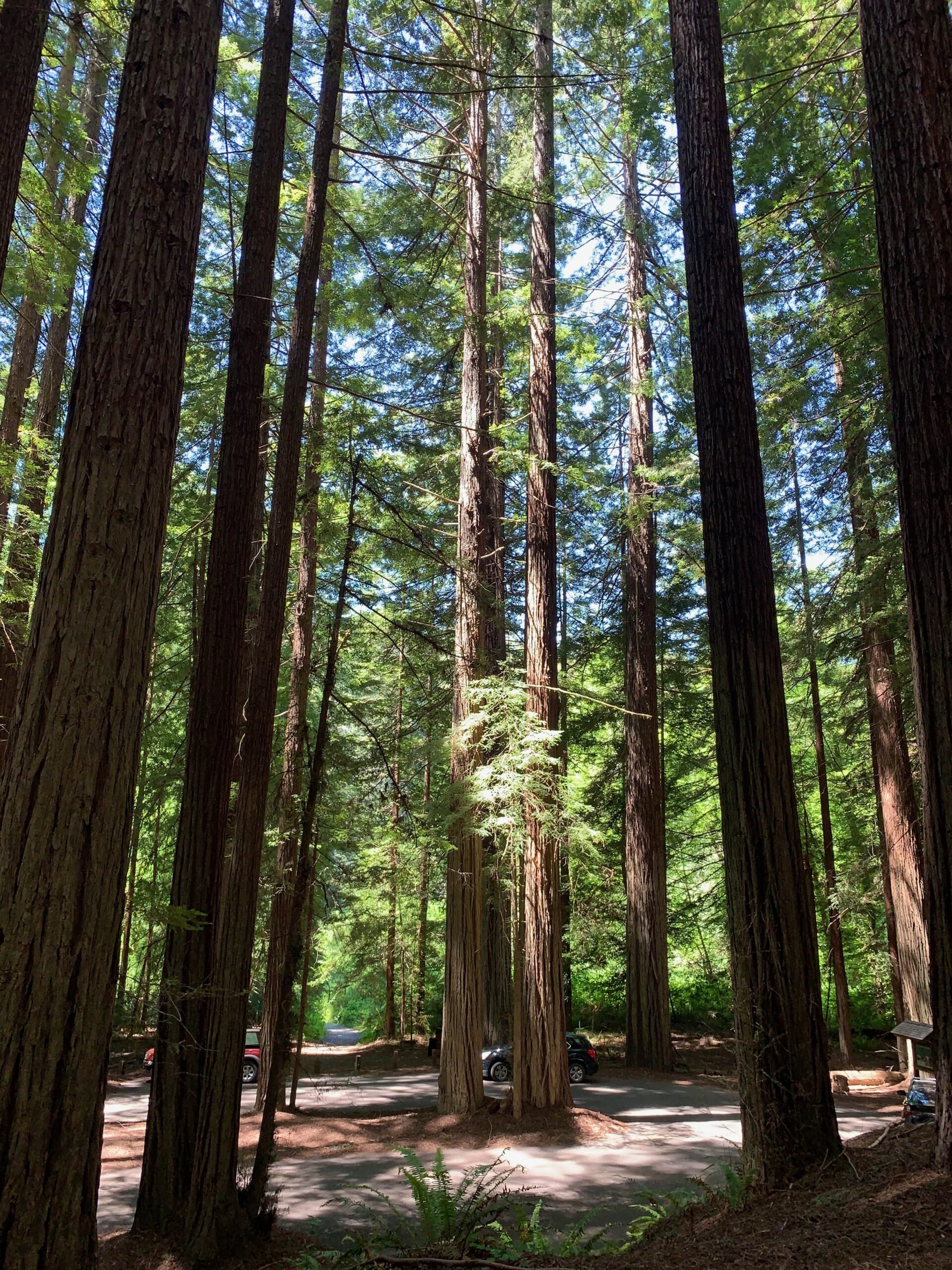
California’s famed redwood forests are like cathedrals of nature. Just as the Rockies, or the Andes or the Alps, are expressions of enormity, the redwoods show the enormity of things that can grow out of the soil, if the conditions are right are they are just left to their own devices. The redwoods love the coastal climate where the winters are cold and in the summer, balmy sunshine is mixed with Pacific Ocean sea mists that drift inland and drench the forests regularly. Some of the redwoods are thousands of years old. Some of them have trunks that, at their base, are several meters in diameter. They look like spears, a multitude of sentinels standing as tall as they eye can see. Their needles are tiny, much smaller than the average Scots pine needles familiar to us in Ireland, and, typically, they don’t have many lower branches, so there’s room for growth on the forest floor for ferns and other smaller plants. These really are coastal rain forests, full of lush growth and strength.
The Avenue of the Giants is narrow — one lane only in either direction for most of it — and is full of bends. The redwoods extend right up to the edge of the road, so you ride carefully. Any contact at all with the trees would likely be fatal because the trunks are hard as concrete and big, really big. The avenue hugs the banks of the Eel River, which appears in flashes between the trunks as I ride. The water looks alternatively turquoise blue or silver, or sometimes a frothy white water rafting white where there’s rocks. Sun light streams through the upper reaches of the trees and the whole thing is a bit like looking at nature through a zoetrope, the Victorian spinning drum, with side slits showing objects that appear to move with the spin.
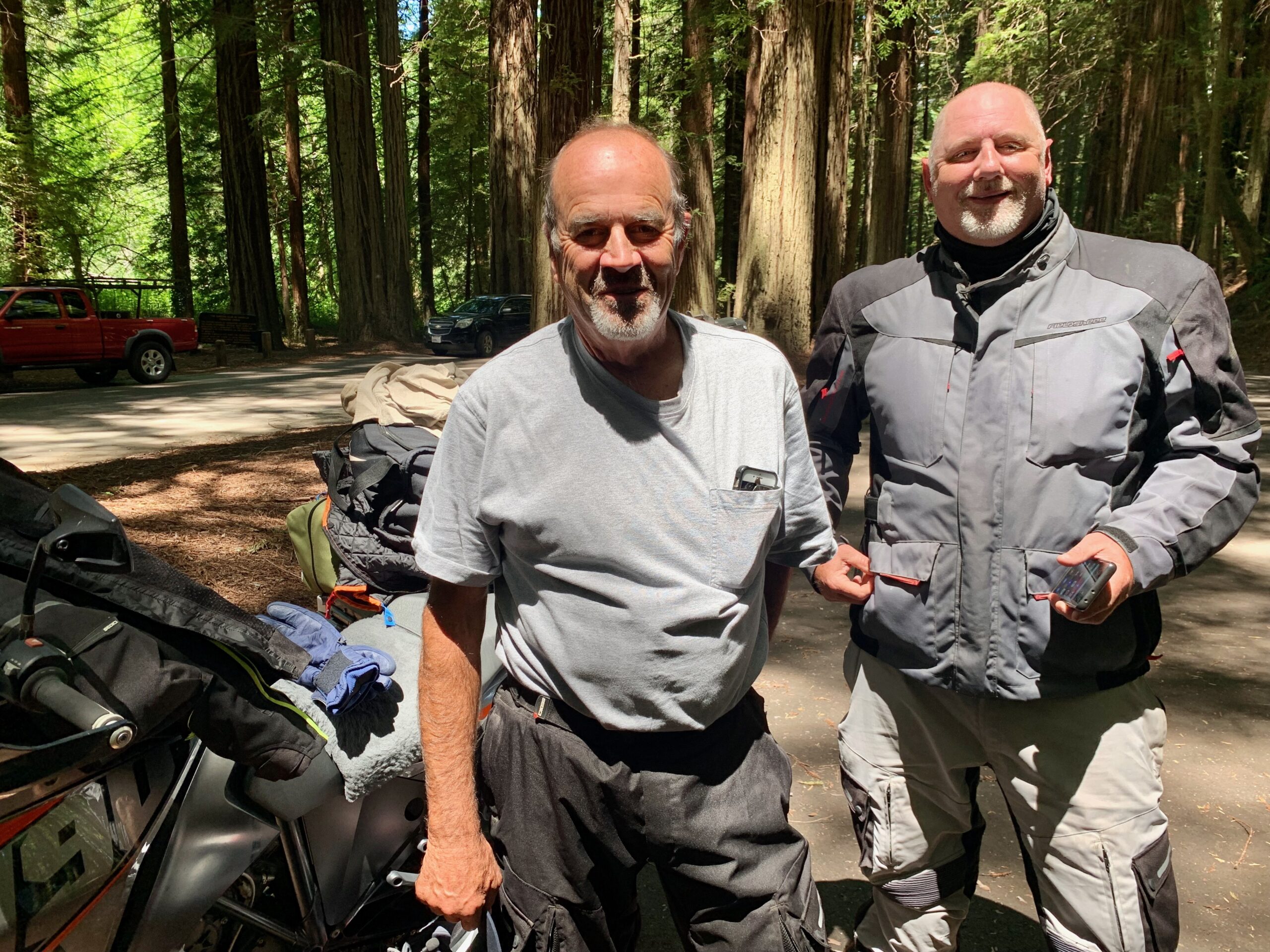
There’s a sign at a place named Leggett that says “Chandelier Drive Thru Tree” and so I pull into the nearby gas station and shop for a coffee break. There too are two other bikers there also, Kyle Koshman and John Renquist, both living elsewhere in California. Kyle (47) is riding an Africa Twin CRF 1100., while John (71) rides a KTM Adventure 1190.
Kyle emerged from the gas station store with the advice, gleaned apparently from someone inside, that when we go down at the drive thru tree, we should say that “Shelby sent us” and we’d likely get in for free. It’s on private land and the owners have been making a good living from tourists for years. The usual fee is $15. None of us had any idea who, or what, Shelby is or was. But what the hell? We ride off together, down to the entrance and, lo and behold, “Shelby sent us” works and we’re waved through for nothing!
The tree is vast, probably fully three times the width of a car but large a square hole, or tunnel, was carved out of the centre of the trunk in 1937 by woodsmen working for the the owners Charlie and Hazel Underwood, whose family own the tree still. The tree is alive and apparently thriving, despite being molested in this way and having goodness knows how many hundreds of thousands of vehicles driven through it. We arrive and there’s a car stuck half way through the trunk, the driver rather trying delicately to negotiate his way through with two bicycles mounted on the rear, one of whose wheels is stuck and preventing the car moving forward. Eventually, his wife removes the bikes and unblock the tree, as it were. We follow through and do what must be done: take photos.
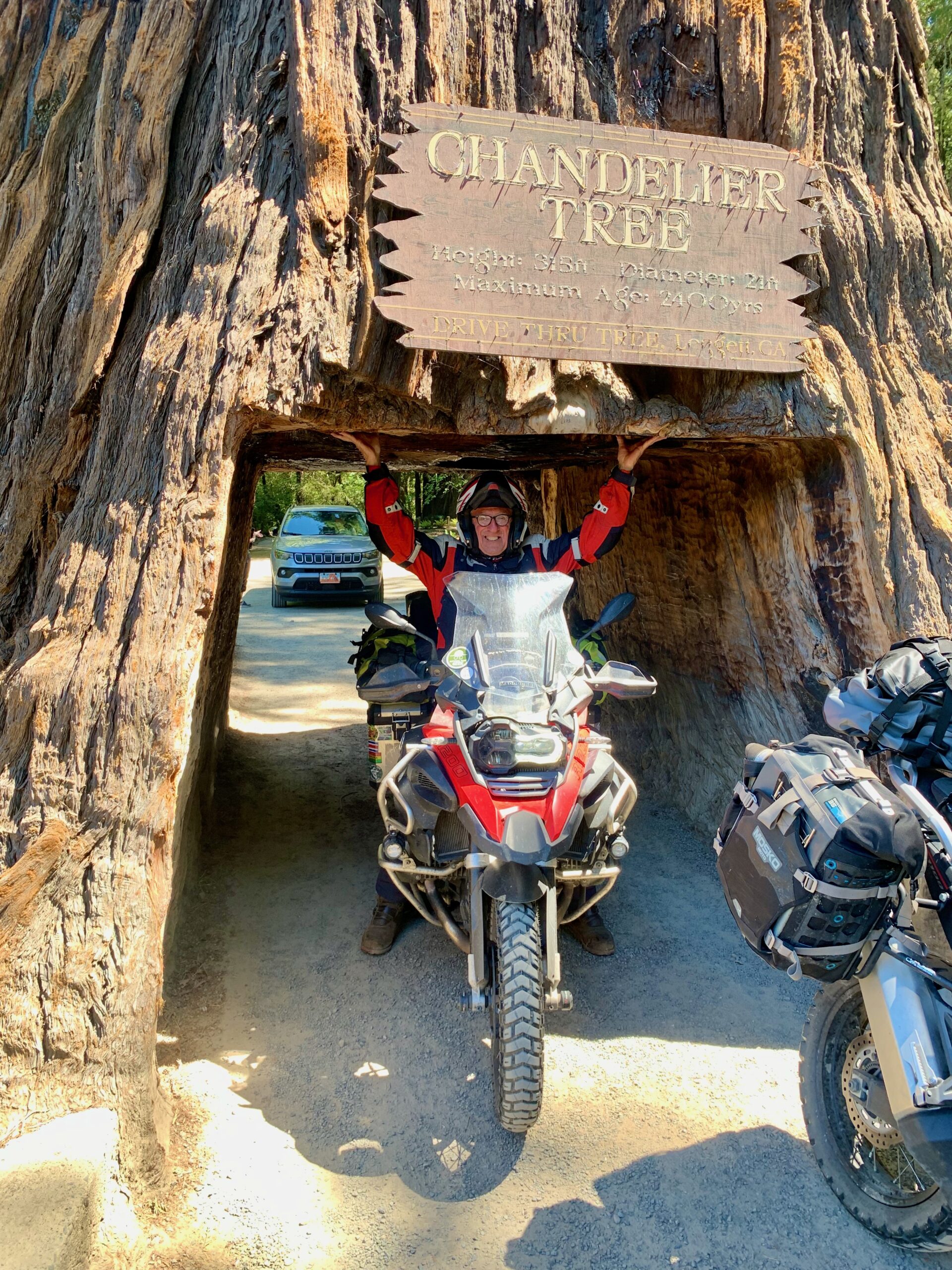
Kyle and John are two good biking companions for the afternoon and so we ride off, at their invitation, and head for lunch in Ferndale, a Victorian town just north off the 101 south of Eureka. It always interests me to know what other people do for a living, and often surprises too, with occupations you had no idea existed. Kyle’s job is to certify as fit and competent people who go up mobile phone and other masts. John, who I suspect has a few business irons in the fire, is mad about flying and works for Skytypers Inc, a sort of dare devil outfit whose pilots use their planes to write promotional messages in the sky. Think Red Arrows meets Madison Avenue. . . He has his own Cessna 180 and lives on an airstrip, the way some other people live on the edge of a golf course.
They’re heading due south and me in the opposite direction. So we part company after lunch and I head north, camping the night in Elk Country RV park — surrounded by a herd of freely roaming elk. Later I meet a fairly large fellow, truly in the wild, just grazing a field by the road.
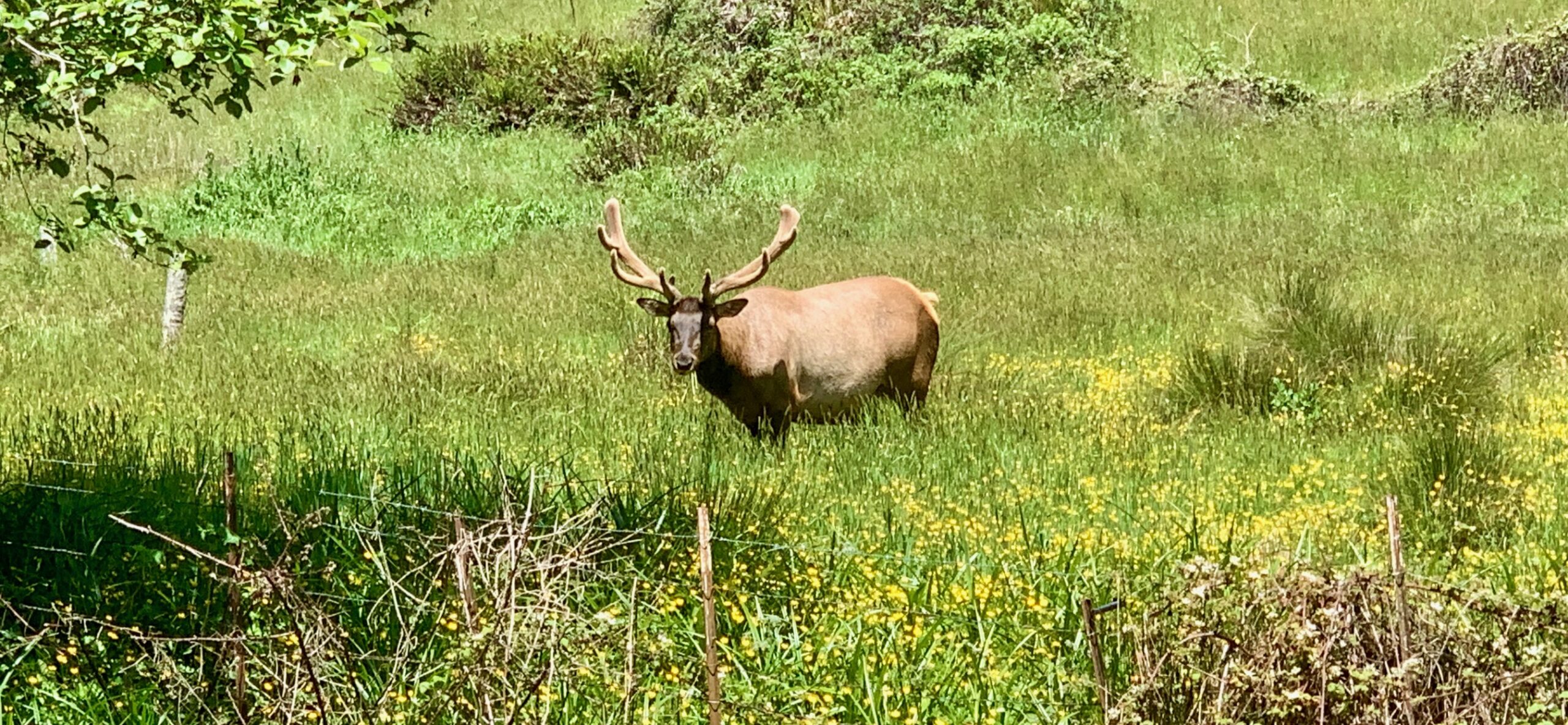
Next day, I’m off up Highway 101 again, stopping soon at a place named Klamath (population 632) in the hope of a coffee, and maybe some over easy eggs and bacon. I don’t find any but see once again, in a sort of “nothing and going nowhere main street,” the depressing sight of a hotel and casino that says this is yet another native American “reservation” — what a horrible word — this one for the Yurok tribe. But there’s a coffee shop-cum-second hand bookshop where a young woman directs me to the visitor centre down the road. Here among much information is revealed an ancient relationship with nature that only recently the rest of the world has maybe begun to emulate, to some degree.
Northern California has the greatest diversity of native American tribes in the state and some 90 different languages remain extant. The largest tribe is the Yurok, of whom there are between 5,000 and 6,000. The visitor centre sells souvenirs and houses an exhibition about the Yurok. The first thing that strikes is the enormity of the importance of forest and the river, the Klamath River, was, and is, to the Yoruk. “The river is everything to me,” says a displayed quote from a Barry Wayne McCovey, a member of the tribe. “It is my home, church, garden, highway, counsellor, friend, brother and provider.”
For thousands of years before the arrival of Europeans, the Yurok lived between the mountains and the sea, along the banks of the river, in the forest and by the Pacific coast, which is only maybe a mile to the west. The redwood tree was imbued by them with a divine characteristic: it was a sacred being, “a woge, or spirit person, who created the earth”, as the exhibition explains. The Yurok were river people, living off salmon — ne po y’or, in the Yurok language, meaning “that which is eaten” — and also eels.
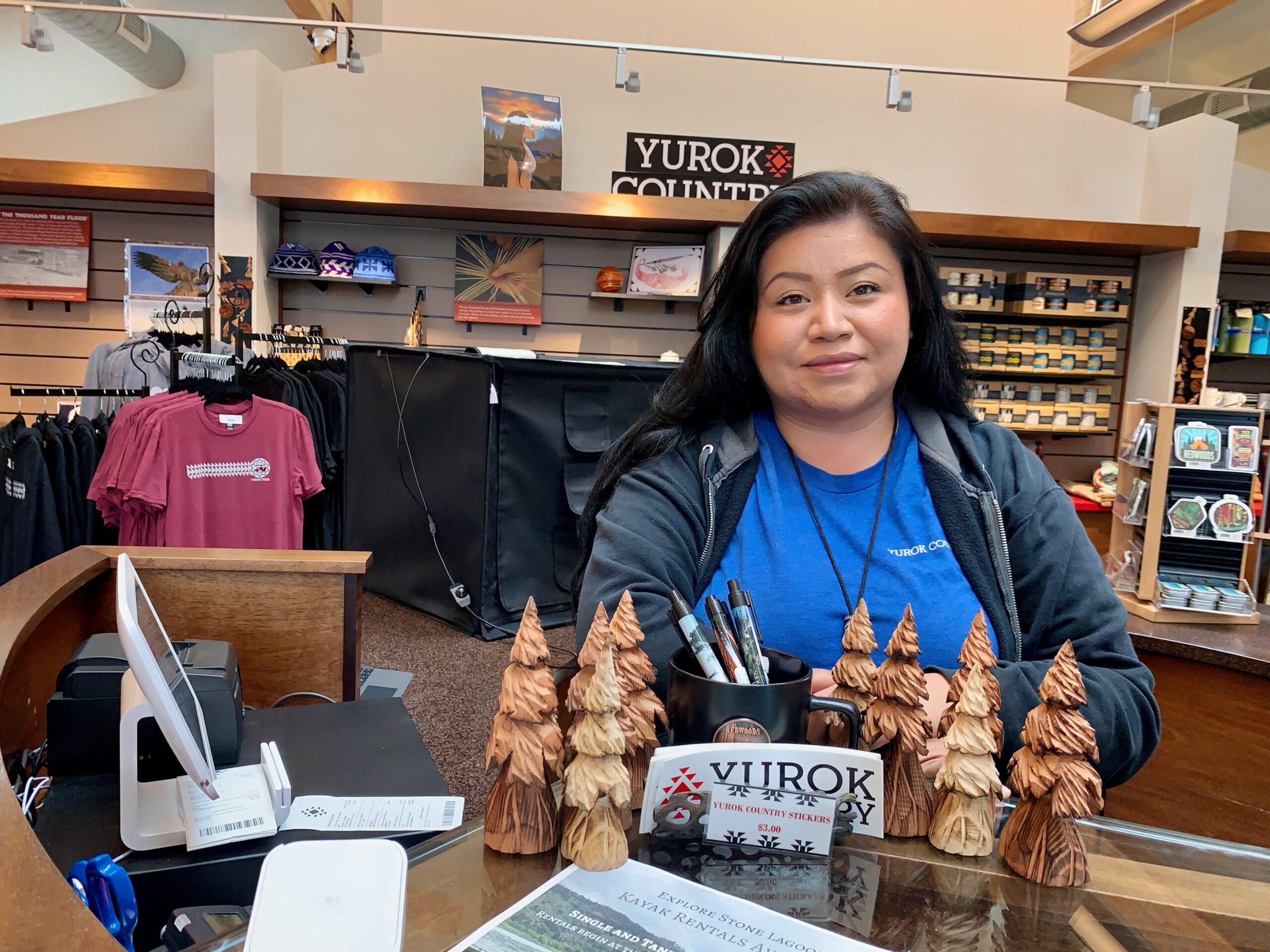
“Fishing was mostly done by men,” I’m told by Antonette (“but everybody calls me Teddy”) who runs the center. She’s enrolled as a member of the Pit River tribe in north-eastern California because her father is from there. “Women are not supposed to go eel fishing,” she tells me. “I haven’t understood why but they say if a woman touches a man’s eel hook, they have to burn it. So don’t touch it. It’s just something you learn at school.”
There wasn’t much impact when the Europeans came until the gold rush in the mid-19th century which, as the exhibition puts it, was “the most troubling time in the Tribe’s history”. The Indians stood in the way of what the impatient prospectors wanted, and wanted fast, and efforts were made to, in effect, wipe out the Indians by killing their language. Families were broken up and children were sent away to English-speaking schools as a way of killing the Yurok language. This was the brainchild of one Lieutenant Richard Pratt, of the US Army, who founded the Carlisle Indian Industrial School in Pennsylvania. He is credited with first using the term “racism” when criticising racial segregation, a view that appears to have gone hand in hand with support for aggressive assimilation. The aim of his school, of which there were 150 across the US by 1900, was to “kill the Indian in him and save the man”, as he said in 1892. But in many instances, he achieved both: the exhibition discloses that an astonishing 50 per cent of Yurok children sent to the schools to kill their native language themselves died. I could not see any explanation, any cause, given in the exhibition for such a horrific rate of death.
In the 1970s, Yurok elders resolved to try to reverse a by then well-established trend and revive the language. It is now taught in public middle and secondary schools.
Does she speak it, I asked Teddy of the 3-year old girl, Annelane, her daughter, playing on the floor? “She learns a little from flash cards at [play] school,” she said.
A little further along 101, I stop at a cafe opposite the “Trees of Mystery”, a tourist trap where there’s a bloke with a microphone and loudspeakers. Wherever he is, he able to address people in the car park. “Hey bud, you heading off?” he broadcasts to one departing driver as another arrives. “Well, have a great day. Yo! Lady, welcome to the Trees of Mystery!”
All around are the magnificent redwoods, pristine nature and reminders of a tragic history but the sound of this utter fool bellowing through the air has me riding on as fast as I can.
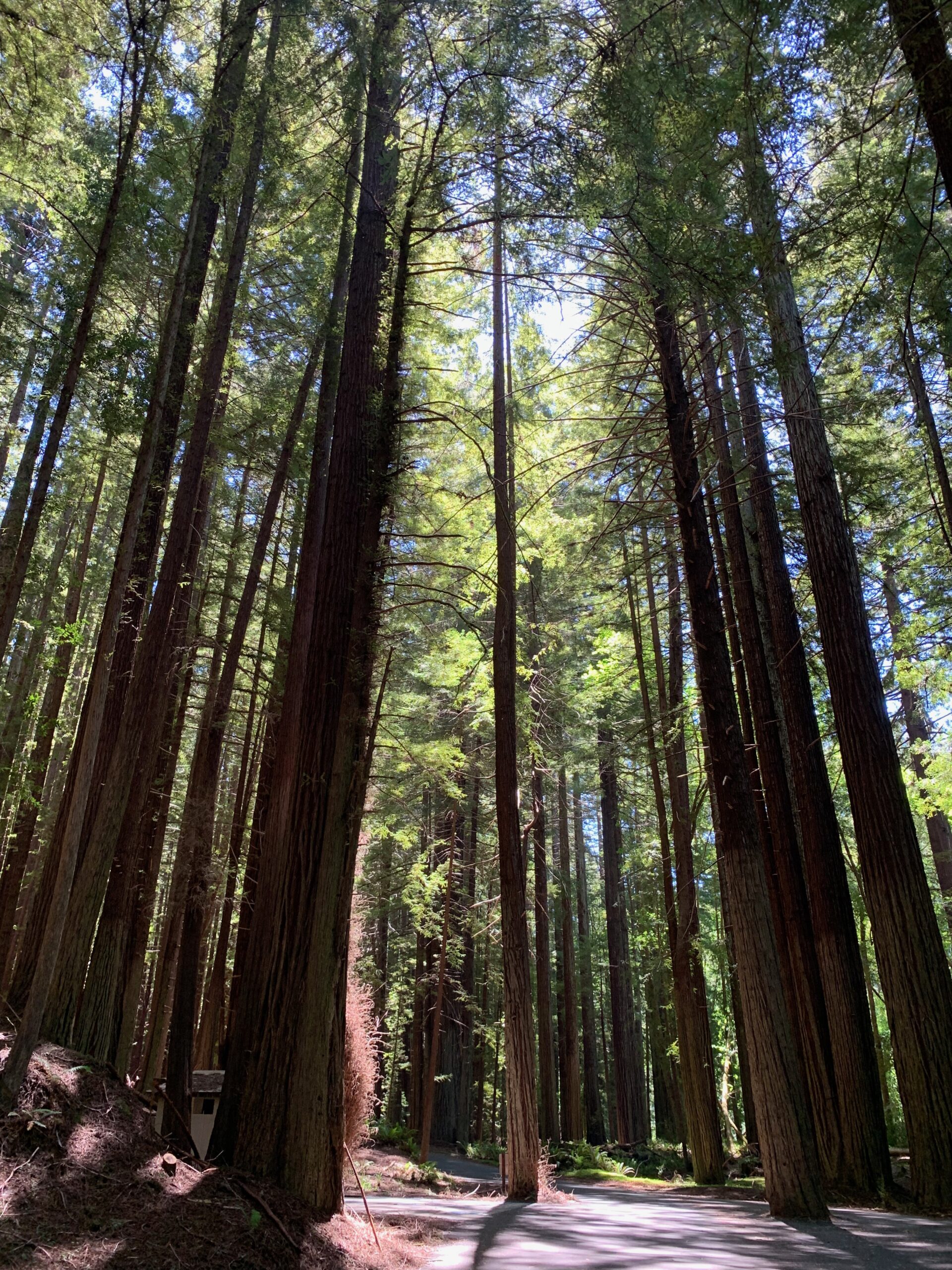
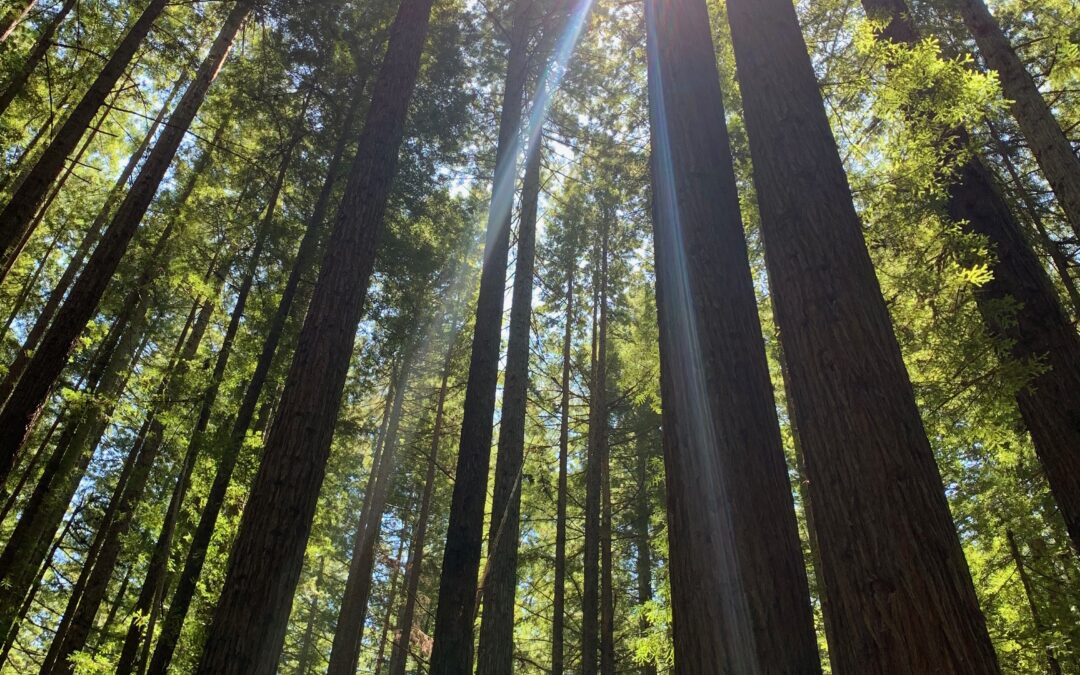
Good one. Makes me wish I was there!
Nice writing as ever. Enjoying your blog. Just wanted to mention that Highway 1 and Highway 101 are referred to in that way, and not by routes, never R101 or R1. I got momentarily confused when you used those references, thinking you must have left the state!
Oops, on my part — thanks for pointing that out. I guess I was thinking of Route 66. Cultural learnings, and all that, as Borat might have said. Have changed accordingly. Best — Peter